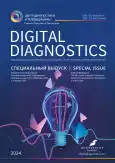Medical phantom of the knee joint for computed tomography studies
- Autores: Belyakova E.D.1, Nasibullina A.A.1, Bulgakova J.V.1, Vlasova O.V.1, Grebennikova V.V.1, Omelyanskaya O.V.1, Petraikin A.V.1, Leonov D.V.1
-
Afiliações:
- Research and Practical Clinical Center for Diagnostics and Telemedicine Technologies
- Edição: Volume 5, Nº 1S (2024)
- Páginas: 115-117
- Seção: Articles by YOUNG SCIENTISTS
- URL: https://bakhtiniada.ru/DD/article/view/261116
- DOI: https://doi.org/10.17816/DD627089
- ID: 261116
Citar
Texto integral
Resumo
BACKGROUND: The knee joint is a frequently visualized anatomical region in clinical practice. Accurate interpretation of CT scans necessitates a comprehensive understanding of anatomy and a sound grasp of fundamental technical principles and imaging protocols. To safeguard the patient's well-being, it is of paramount importance to prevent erroneous studies resulting from suboptimal equipment quality, setup issues, and patient positioning. These difficulties can be circumvented by the use of phantoms to pre-adjust the equipment and the provision of training to medical staff in scanning techniques.
AIM: The aim of the study was to develop a technique for creating an anthropomorphic medical phantom of the knee joint that would accurately reflect the X-ray density of the corresponding human tissues, thus enabling the use of computed tomography studies.
MATERIALS AND METHODS: The knee joint phantom comprises a series of models representing the femur, tibia, fibula, patella, collateral ligaments, lateral and medial menisci, tendon of the quadriceps femoris muscle, anterior and posterior cruciate ligaments, and patellar ligament. Ligament models were 3D-printed from resin, bones were cast from silicone, soft tissues were modeled with a homogeneous structure of silicone-like materials and made by casting into silicone molds. The skin was similarly modeled. In the study, the anode voltage range of the CT scanner varied from 80 to 140 kV, and the slice thickness was equal to 1.25 mm.
RESULTS: The developed anthropomorphic knee joint phantom demonstrated the X-ray density of the modeled anatomical structures, with ligaments exhibiting a range of 80–120 units on the Hausfield scale, bones exhibiting a range of 320–370 units, and soft tissues and skin exhibiting a range of 20–60 units. The use of additive technologies made it possible to achieve a high degree of similarity between the phantom forms and the knee joint. Further research may be directed towards the creation of a more complex model of bone tissue, comprising a separate cortical layer and spongy substance.
CONCLUSIONS: The use of an anthropomorphic knee phantom allows for the acquisition of high-quality CT images without the need for prior scanning of patients.
Palavras-chave
Texto integral
##article.viewOnOriginalSite##Sobre autores
Ekaterina Belyakova
Research and Practical Clinical Center for Diagnostics and Telemedicine Technologies
Email: belyakova_e_d@student.sechenov.ru
ORCID ID: 0009-0009-0316-0628
Rússia, Moscow
Anastasia Nasibullina
Research and Practical Clinical Center for Diagnostics and Telemedicine Technologies
Email: NasibullinaAA@zdrav.mos.ru
ORCID ID: 0000-0003-1695-7731
Código SPIN: 2482-3372
Rússia, Moscow
Julia Bulgakova
Research and Practical Clinical Center for Diagnostics and Telemedicine Technologies
Email: BulgakovaYV@zdrav.mos.ru
ORCID ID: 0000-0002-1627-6568
Código SPIN: 8945-6205
Rússia, Moscow
Olga Vlasova
Research and Practical Clinical Center for Diagnostics and Telemedicine Technologies
Autor responsável pela correspondência
Email: VlasovaOV10@zdrav.mos.ru
ORCID ID: 0000-0002-4211-9566
Código SPIN: 4492-3864
Rússia, Moscow
Veronika Grebennikova
Research and Practical Clinical Center for Diagnostics and Telemedicine Technologies
Email: GrebennikovaVV@zdrav.mos.ru
ORCID ID: 0009-0003-6041-132X
Código SPIN: 4949-1057
Rússia, Moscow
Olga Omelyanskaya
Research and Practical Clinical Center for Diagnostics and Telemedicine Technologies
Email: OmelyanskayaOV@zdrav.mos.ru
ORCID ID: 0000-0002-0245-4431
Código SPIN: 8948-6152
Rússia, Moscow
Alexey Petraikin
Research and Practical Clinical Center for Diagnostics and Telemedicine Technologies
Email: alexeypetraikin@gmail.com
ORCID ID: 0000-0003-1694-4682
Código SPIN: 6193-1656
MD, Dr. Sci. (Med.)
Rússia, MoscowDenis Leonov
Research and Practical Clinical Center for Diagnostics and Telemedicine Technologies
Email: LeonovDV2@zdrav.mos.ru
ORCID ID: 0000-0003-0916-6552
Código SPIN: 5510-4075
Cand. Sci. (Tech.)
Rússia, MoscowBibliografia
- Kapisiz A, Kaya C, Eryilmaz S, et al. Letter to the Editor in Response to: Reducing Unnecessary Computed Tomography Scan. Journal of pediatric surgery. 2023;58(7):1402. doi: 10.1016/j.jpedsurg.2023.02.048
- Hernandez AM, Bayne CO, Bateni C, et al. Extremity radiographs derived from low-dose ultra-high-resolution CT: a phantom study. Skeletal Radiol. 2024. doi: 10.1007/s00256-024-04600-y
- Leonov D, Venidiktova D, Costa-Júnior JFS, et al. Development of an anatomical breast phantom from polyvinyl chloride plastisol with lesions of various shape, elasticity and echogenicity for teaching ultrasound examination. Int J CARS. 2023;19:151–161. doi: 10.1007/s11548-023-02911-4
- Leonov D, Kodenko M, Leichenco D, Nasibullina A, Kulberg N. Design and validation of a phantom for transcranial ultrasonography. Int J Comput Assist Radiol Surg. 2022;17:1579–1588. doi: 10.1007/s11548-022-02614-2
Arquivos suplementares









